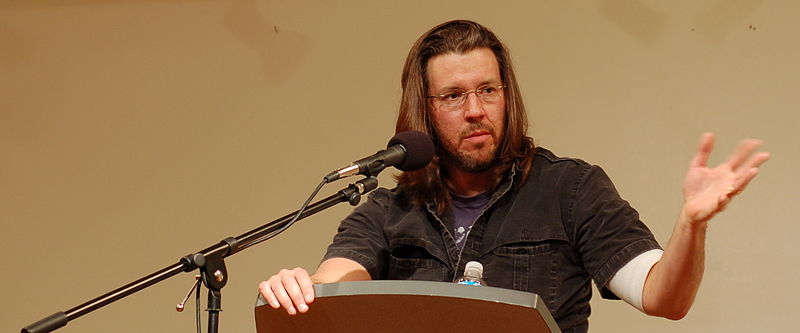“The End of the Tour”: De-halo-ing David Foster Wallace
Donald Margulies’s “The End of the Tour” opens on David Lipsky learning of his friend David Foster Wallace’s suicide through a Google search. Twelve years have elapsed since Lipsky, then a writer for Rolling Stone, sought to unpack the hype-generating author of “Infinite Jest,” a delightfully discursive meditation on American sadness and tennis.
“The End of the Tour” stars Jesse Eisenberg and Jason Segel as David Lipsky and David Foster Wallace respectively. Lipsky accompanies Wallace on the final appearances in the “Infinite Jest” book tour. Lipsky’s presence borders on antagonistic, as is always the role of the journalist. His perception of Wallace swings throughout the film between awe and jealousy. Lipsky’s ever-present dictaphone is a reminder to the audience of the awkwardness of their exchange: any raw outpouring by Wallace is punctuated by embarrassment in the presence of the tape recorder. The film succeeds in its refusal to paint broadly or summatively. It is quite literally just a recreation of the time spent between Lipsky and Wallace. It does not pry into some fatuous, tabloid notion of darkness within Wallace, although Wallace’s inaccessibility is undeniably there. It is a shaky camera, cards-on-the-table account of a series of conversations between two very smart men.
Dave Wallace was born to professors of English and Philosophy in Ithaca, New York in 1962. A graduate of Amherst College and the recipient of a Master of Fine Arts (MFA) in Creative Writing, Wallace often characterized himself as belonging to a group of white, upper middle class, enormously educated and ultimately, deeply sad people. David Wallace hung himself in 2008, in his backyard in Claremont, California, leaving behind an unfinished manuscript of his would-be third novel, “The Pale King.” Wallace suffered bouts of clinical depression throughout his life. The motivations of his choice are reductive to speculate on.
“Infinite Jest,” his second novel, was published when Wallace was 34. It comprises some thousand odd pages and a hundred paper cuts’ worth of endnotes. It is a split narrative with multiple, main protagonists, interknitting the Quebecois Separatist Movement, a rehabilitation center, a tennis academy and a film. Wallace’s style is tangential, self-referential, funny, wickedly convoluted: simultaneously conscious of its place in the literary lineage and yet inherently in-rebellion. Wallace was notedly a disciple of the American post-modernists of the 60s and 70s: Pynchon, Barth, Gaddis and DeLillo.
“[Postmodernism] was the first text that was highly self-conscious: self-conscious of itself as text, self-conscious of the writer as persona, self-conscious about the effects that narrative had on readers and the fact that the readers probably knew that,” Wallace said in a 1997 appearance on “Charlie Rose.” “It was the first generation of writers who’d actually read a lot of criticism.”
Wallace’s death in 2004 suggested a conversation which has yet to take place. It is a conversation about pleasure and fraudulence and cultural phenomenality. The culture of the world as it stands, falls too often into one of rubbernecking: morbid curiosity. This has something to with the romanticization of death and prophecy. The fatal flaw of postmodernism is that it becomes a circular practice. The postmodernist’s exorcism of excess and hedonism becomes incorporated into the culture: the anti-commercial becomes commercial. There was the generation of chip-shouldered young men who pantomimed James Dean in their bedroom mirrors. There were the post-effeminate, flower-sniffing, Cobain-worshippers. There was the class of grad-school rejects who fell on Charles Bukowski like Charles Bukowski on whiskey. There were the pubescent literary dreamers who thumbed their copies of Proust in the dark. It’s an unbreakable cycle: appreciation through self-absorption. This was Wallace’s realization.
“And the problem, though, is that a lot of the schticks of postmodernism — irony, cynicism, irreverence — are now part of whatever it is that’s enervating in the culture itself, right?” Wallace said. “Burger King now sells hamburgers with ‘You gotta break the rules,’ right? So I’m — I don’t really consider myself a postmodernist. I don’t consider myself much of anything, but I know that that’s the tradition that excited me when I was starting to write.”
At this very moment, there are copies of “Infinite Jest” sitting on bookshelves across the country, savagely dog-eared and chicken-scratched, gathering doubt. “Infinite Jest” succeeded because it was not “self-conscious of itself as text” — it was self-conscious of itself as being self-conscious. It fluttered briefly in a place of its own design in the American thought-space and made everyone a little less lonely. Now, it has undoubtedly entered the realm of the classifiable, the canon of contemporary American writing, which is not a bad thing. David Wallace was a beautiful writer. That is what’s important.




Robert Barker | Oct 8, 2015 at 8:53 am
Eli,
Thank you for this thoughtful piece. You capture Wallace’s mercurial nature with precision.
About that 2004 conversation re: American navel-gazing: it does continue — with your words. Thanks. As much as I love Wallace, I don’t think irony has to fail completely; we just have to use it more judiciously and not mistake it for a solution in and of itself. Being self-conscious about being continually self-conscious can seem pretentious. Or it can be laugh out loud funny and thought-provoking. Wallace, for me, achieved the latter.
For readers intrigued by Wallace, I recommend starting by reading “This is Water” — a commencement speech he gave at Kenyon College some years back, and watching the video based on that speech: Here’s a link for anyone with interest to learn more: https://vimeo.com/68855377
For more literary interests, his short story collections (Oblivion, Brief Interviews with Hideous Men, The Girl with Curious Hair) and essay collections (most notably A Supposedly Fun Thing I’ll Never Do Again and Consider The Lobster) are great starts.
Thanks again for your article.
Robert Barker
English Teacher
Los Altos High School